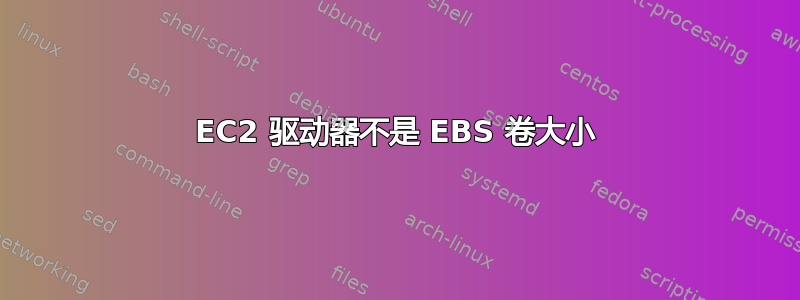
我有一个 EC2 实例,为其创建了一个 500GB 的 EBS 卷。不幸的是,EC2 实例仅显示 8GB 可用。
我只有一个驱动器,这是正确的。
[root@ip-10-244-134-250 ~]# ls -la /dev/x*
brw-rw---- 1 root disk 202, 1 Aug 7 08:54 /dev/xvda1
但该驱动器只有 8GB
[root@ip-10-244-134-250 ~]# df -h
Filesystem Size Used Avail Use% Mounted on
/dev/xvda1 8.0G 1.3G 6.7G 16% /
tmpfs 3.7G 0 3.7G 0% /dev/shm
但是,fdisk 和 /proc/partitions 都显示正确的大小
[root@ip-10-244-134-250 ~]# fdisk -l
Disk /dev/xvda1: 536.9 GB, 536870912000 bytes
255 heads, 63 sectors/track, 65270 cylinders
Units = cylinders of 16065 * 512 = 8225280 bytes
Sector size (logical/physical): 512 bytes / 512 bytes
I/O size (minimum/optimal): 512 bytes / 512 bytes
Disk identifier: 0x00000000
Disk /dev/xvda1 doesn't contain a valid partition table
[root@ip-10-244-134-250 ~]# cat /proc/partitions
major minor #blocks name
202 1 524288000 xvda1
任何帮助都将不胜感激,谢谢。
答案1
如果根文件系统是 ext3 或 ext4,则运行:
sudo resize2fs /dev/xvda1
如果根文件系统是 xfs(不太常见),则运行:
sudo xfs_growfs /
如果您以 root 身份登录,则可以省略“sudo”。
这些命令应该在系统运行和文件系统挂载时运行。
EBS 卷不包含分区表是标准做法。EBS 卷通常被格式化为整个文件系统,没有分区。
答案2
这里的答案似乎缺少在调整大小之前的一些步骤,特别是对于那些正在更改其 EBS 卷大小的人。如果您使用快照创建 EBS 或使用某些 AMI,您将需要扩展磁盘 (xvda)、扩展分区 (xvda1),然后扩展文件系统 (/)。
如果我没看错的话,你的磁盘看起来是这样的:
/dev/xvda
|__/dev/xvda1__|______________ Free space______________|
它需要看起来像这样:
/dev/xvda
|______________________/dev/xvda1______________________|
之后,运行resize2fs将增长到新的空间内xvda1,使用fdisk我们可以通过删除并再次创建它并使分区可引导来增加块大小。它只需要重新启动。在大多数情况下,如果您使用相同的起始柱面,它不会影响您的数据,但请注意,重新创建分区时的任何错误都将导致丢失所有数据和/或服务器无法重新启动。
我建议在新创建的实例上首先执行此操作。否则,请拍摄 EC2 EBS 存储等的快照。
我在下面的块中用 <<#>> 标记了这些步骤,因此它们不是命令的一部分。您需要 root 权限,因此如果您不是 root,请执行“sudo sh”。
<<1>> Look at the filesystem, it is 6G
<<2>> Look at the disk and the partition, the disk is 21.5 GB but the partition is 6 GB (6291456 blocks)
<<3>> Start fdisk for that disk (xvda, so not the partition xvda1)
<<4>> Switch to sector display.
<<5>> Print the partition(s), and remember the start sector (2048 in the example).
<<6>> Delete the partition.
<<7>> Create a new partition.
<<8>> Make it primary.
<<9>> First partition.
<<10>> Enter the old start sector, do NOT make any typo here!!! (2048 in the example)
<<11>> Hit enter to accept the default (this is the remainder of the disk)
<<12>> Print the changes and make sure the start sector is ok, if not restart at <<6>>
<<13>> Make the partition bootable. do NOT forget this!!!
<<14>> Enter your partition number (1 in the example)
<<15>> Write the partition info back, this will end the fdisk session.
<<16>> Reboot the server, and wait for it to come up (this may take longer than usual).
<<17>> Verify the filesystem size.
<<18>> If the filesystem is not around 20Gb as expected, you can use this command.
# df -h <<1>>
Filesystem Size Used Avail Use% Mounted on
/dev/xvda1 6.0G 2.0G 3.7G 35% /
tmpfs 15G 0 15G 0% /dev/shm
# fdisk -l <<2>>
Disk /dev/xvda: 21.5 GB, 21474836480 bytes
97 heads, 17 sectors/track, 25435 cylinders
Units = cylinders of 1649 * 512 = 844288 bytes
Sector size (logical/physical): 512 bytes / 512 bytes
I/O size (minimum/optimal): 512 bytes / 512 bytes
Disk identifier: 0x0003b587
Device Boot Start End Blocks Id System
/dev/xvda1 * 2 7632 6291456 83 Linux
# fdisk /dev/xvda <<3>>
WARNING: DOS-compatible mode is deprecated. It's strongly recommended to
switch off the mode (command 'c') and change display units to
sectors (command 'u').
Command (m for help): u <<4>>
Changing display/entry units to sectors
Command (m for help): p <<5>>
Disk /dev/xvda: 21.5 GB, 21474836480 bytes
97 heads, 17 sectors/track, 25435 cylinders, total 41943040 sectors
Units = sectors of 1 * 512 = 512 bytes
Sector size (logical/physical): 512 bytes / 512 bytes
I/O size (minimum/optimal): 512 bytes / 512 bytes
Disk identifier: 0x0003b587
Device Boot Start End Blocks Id System
/dev/xvda1 * 2048 12584959 6291456 83 Linux
Command (m for help): d <<6>>
Selected partition 1
Command (m for help): n <<7>>
Command action
e extended
p primary partition (1-4)
p <<8>>
Partition number (1-4): 1 <<9>>
First sector (17-41943039, default 17): 2048 <<10>>
Last sector, +sectors or +size{K,M,G} (2048-41943039, default 41943039): <<11>>
Using default value 41943039
Command (m for help): p <<12>>
Disk /dev/xvda: 21.5 GB, 21474836480 bytes
97 heads, 17 sectors/track, 25435 cylinders, total 41943040 sectors
Units = sectors of 1 * 512 = 512 bytes
Sector size (logical/physical): 512 bytes / 512 bytes
I/O size (minimum/optimal): 512 bytes / 512 bytes
Disk identifier: 0x0003b587
Device Boot Start End Blocks Id System
/dev/xvda1 2048 41943039 20970496 83 Linux
Command (m for help): a <<13>>
Partition number (1-4): 1 <<14>>
Command (m for help): w <<15>>
The partition table has been altered!
Calling ioctl() to re-read partition table.
WARNING: Re-reading the partition table failed with error 16: ...
The kernel still uses the old table. The new table will be used at
the next reboot or after you run partprobe(8) or kpartx(8)
Syncing disks.
# reboot <<16>>
<wait>
# df -h <<17>>
Filesystem Size Used Avail Use% Mounted on
/dev/xvda1 20G 2.0G 17G 11% /
tmpfs 15G 0 15G 0% /dev/shm
# resize2fs /dev/xvda1 <<18>>
resize2fs 1.41.12 (17-May-2010)
Filesystem at /dev/xvda1 is mounted on /; on-line resizing required
old desc_blocks = 1, new_desc_blocks = 2
Performing an on-line resize of /dev/xvda1 to 5242624 (4k) blocks.
The filesystem on /dev/xvda1 is now 5242624 blocks long.
root@vs120 [~]# df -h
Filesystem Size Used Avail Use% Mounted on
/dev/xvda1 20G 7.8G 11G 42% /
tmpfs 498M 0 498M 0% /dev/shm
/usr/tmpDSK 399M 11M 368M 3% /tmp
root@vs120 [~]#
答案3
调整 EBS 卷上的文件系统大小。如果您正在运行ext3(通常是默认设置),则只需运行e2resize /dev/xvda1。
答案4
我尝试使用从自定义 Ubuntu AMI 创建的实例来回答 @Neo 的问题。解释非常有帮助,但我需要将单位保留为块并跳过步骤 #4。然后它完美地工作了。
另外要注意的是,在步骤#5中,您必须复制起始块/圆柱体以供在步骤#10中使用。
@Neo 的答案是,如果您有一个分区的虚拟磁盘设备。您可以通过以下方式查找是否遇到此问题:
lsblk
NAME MAJ:MIN RM SIZE RO TYPE MOUNTPOINT
xvda 202:0 0 30G 0 disk
└─xvda1 202:1 0 5G 0 part /
xvda 和 xvda1 的大小差别很大。您可以 resize2fs,这不会有任何区别,在我的情况下,xvda1 是 5G,这就是文件系统将使用的全部。
fdisk 的后续版本可能提示你:
Created a new partition 1 of type 'Linux' and of size 200 GiB.
Partition #1 contains a ext4 signature.
Do you want to remove the signature? [Y]es/[N]o: N
您必须回复 N,否则它会擦除分区签名。
谢谢,@Neo


